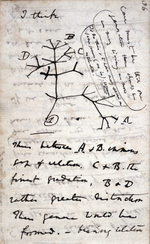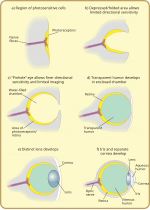The evolution of the molluscs is the way in which the Mollusca, one of the largest groups of invertebrate animals, evolved. This phylum includes gastropods...
27 KB (2,671 words) - 15:15, 30 July 2024
Mollusca (redirect from Sex organs of molluscs)
characteristic of molluscs is they are unsegmented and bilaterally symmetrical. The following are present in all modern molluscs: The dorsal part of the body...
98 KB (9,825 words) - 00:31, 19 November 2024
Spiralia are a morphologically diverse clade of protostome animals, including within their number the molluscs, annelids, platyhelminths and other taxa....
17 KB (1,354 words) - 09:28, 8 November 2024
dispute as to whether these shell-bearing molluscs form a monophyletic group (conchifera) or whether shell-less molluscs are interleaved into their family tree...
41 KB (4,866 words) - 01:10, 3 November 2024
Evolution is the change in the heritable characteristics of biological populations over successive generations. It occurs when evolutionary processes...
240 KB (24,900 words) - 23:29, 21 November 2024
of vertebrates, while scallops have up to 100 simple eyes. There are between seven and eleven distinct eye types in molluscs. Molluscs have eyes of all...
3 KB (319 words) - 07:43, 18 March 2024
diversification of butterflies through geologic time Peppered moth evolution – Significance of the peppered moth in evolutionary biology Evolution of molluscs – The...
26 KB (4,569 words) - 21:37, 9 October 2024
The evolution of cetaceans is thought to have begun in the Indian subcontinent from even-toed ungulates (Artiodactyla) 50 million years ago (mya) and to...
83 KB (9,845 words) - 22:20, 15 November 2024
Animal (redirect from Animal (Metazoan) Evolution)
includes the molluscs, annelids, brachiopods, nemerteans, bryozoa and entoprocts. The molluscs, the second-largest animal phylum by number of described species...
129 KB (11,466 words) - 09:23, 17 November 2024
The evolution of mammals has passed through many stages since the first appearance of their synapsid ancestors in the Pennsylvanian sub-period of the...
141 KB (15,179 words) - 19:52, 18 November 2024
Protostome (section Evolution)
reverse is typically true of its sister clade, Deuterostomia. Well-known examples of protostomes are arthropods, molluscs, annelids, flatworms and nematodes...
11 KB (833 words) - 15:00, 23 October 2024
Feliformia (redirect from Evolution of feliform mammals)
form of the species and, like their mainland counterparts, ranges from small mammals, insects and invertebrates through to crustaceans and molluscs. Family...
22 KB (2,177 words) - 00:19, 19 November 2024
timeline of human evolution outlines the major events in the evolutionary lineage of the modern human species, Homo sapiens, throughout the history of life...
88 KB (3,574 words) - 10:30, 19 November 2024
scientists and philosophers of science have described evolution as fact and theory, a phrase which was used as the title of an article by paleontologist...
45 KB (5,249 words) - 22:09, 17 October 2024
Many scientists have found the evolution of the eye attractive to study because the eye distinctively exemplifies an analogous organ found in many animal...
46 KB (5,483 words) - 02:16, 20 November 2024
Marine invertebrates (redirect from Evolution of marine invertebrates)
the largest shell of any living gastropod Molluscs usually have eyes. Bordering the edge of the mantle of a scallop, a bivalve mollusc, can be over 100...
63 KB (6,568 words) - 03:23, 8 October 2024
Phanerozoic (section Eras of the Phanerozoic)
diverse forms; the evolution of plants; the evolution of fish, arthropods and molluscs; the terrestrial colonization and evolution of insects, chelicerates...
61 KB (6,170 words) - 14:37, 7 November 2024
The evolution of mammalian auditory ossicles was an evolutionary process that resulted in the formation of the mammalian middle ear, where the three middle...
40 KB (4,283 words) - 02:40, 12 November 2024
selection pressures led to the evolution and maintenance of sexual reproduction? (more unsolved problems in biology) Evolution of sexual reproduction describes...
79 KB (9,495 words) - 07:31, 20 October 2024
of insulin that is more similar to fish insulin protein sequences than to insulin from more closely related molluscs, suggesting convergent evolution...
57 KB (5,772 words) - 13:33, 4 November 2024
mainly fossils. In biology, evolution is any change across successive generations in the heritable characteristics of biological populations. Evolutionary...
85 KB (4,733 words) - 00:20, 3 November 2024
Evolution of cells refers to the evolutionary origin and subsequent evolutionary development of cells. Cells first emerged at least 3.8 billion years...
25 KB (3,190 words) - 20:03, 17 October 2024
Bivalvia (redirect from Bivalve molluscs)
class of aquatic molluscs (marine and freshwater) that have laterally compressed soft bodies enclosed by a calcified exoskeleton consisting of a hinged...
122 KB (13,233 words) - 10:13, 1 November 2024
cephalopods. However, because chambered shells are found in a range of molluscs – monoplacophorans and gastropods as well as cephalopods – a siphuncle...
37 KB (4,187 words) - 18:48, 9 November 2024
Darwinian evolution have been proposed by scholars investigating biology to explain signs of evolution and the relatedness of different groups of living...
55 KB (5,851 words) - 21:11, 17 October 2024
Paleontology (redirect from Doctor of Paleontology)
or parts of organisms. Further, only the parts of organisms that were already mineralised are usually preserved, such as the shells of molluscs. Since most...
102 KB (10,183 words) - 12:35, 2 November 2024
"Biochronology of selected mammals, Molluscs and ostracodes from the Middle Pliocene to the Late Pleistocene in Italy. The state of the art" (PDF). Rivista...
176 KB (18,883 words) - 07:11, 18 November 2024
ancestor. This forms an important part of the evidence on which evolutionary theory rests, demonstrates that evolution does occur, and illustrates the processes...
245 KB (27,658 words) - 17:28, 17 October 2024
Tusk shell (category Mollusc shells)
members of a class of shelled marine mollusc with worldwide distribution, and are the only class of exclusively infaunal marine molluscs. Shells of species...
21 KB (2,451 words) - 06:02, 27 September 2024
The evolution of photosynthesis refers to the origin and subsequent evolution of photosynthesis, the process by which light energy is used to assemble...
32 KB (3,704 words) - 22:06, 17 October 2024























